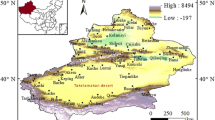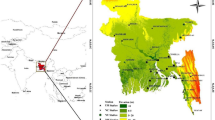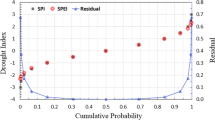Abstract
Effective monitoring of drought plays an important role in water resources planning and management, especially under global warming effect. The aim of this paper is to study the effect of air temperature on historical long-term droughts in regions with diverse climates in Iran. To this end, monthly air temperature (T) and precipitation (P) data were gathered from 15 longest record meteorological stations in Iran covering the period 1951–2014. Long-term meteorological droughts behavior was quantified using two different drought indices, i.e. the Standardized Precipitation Index (SPI) and the Standardized Precipitation Evapotranspiration Index (SPEI). Linear and non-linear trends in T, P, SPI and SPEI were evaluated using non-parametric and parametric statistical approaches such as non-modified and modified Mann-Kendall Test, Theil-Sen approach, and simple regression. The results indicated that the significant trends for temperature are approximately all increasing (0.2 °C to 0.5 °C per decade), and for precipitation are mostly decreasing (−7.2 mm to −14.8 mm per decade). It was also indicated that long-term drought intensities monitored by the SPI and SPEI have had significant downward trend (drought intensification with time) at most stations of interest. The observed trends in the SPI series can be worsen if air temperature (in addition to precipitation) participates in drought monitoring as SPEI. In arid and extra arid climates, it was observed that temperature has strong effects on historical drought characteristics when comparing the SPI and SPEI series. Due to the determinative role of temperature in mostly dry regions like Iran, the study suggests using the SPEI rather than SPI for more effective monitoring of droughts.




Similar content being viewed by others
References
Al-Faraj FAM, Tigkas D, Scholz M (2016) Irrigation efficiency improvement for sustainable agriculture in changing climate: a transboundary watershed between Iraq and Iran. Environ Process 3:603–6016. doi:10.1007/s40710-016-0148-0
Allen RG, Pereira LS, Raes D, Smith M (1998) Crop evapotranspiration: guidelines for computing crop water requirements. FAO Irrigation and Drainage Paper 56, FAO, Italy
Andreadis KM, Lettenmaier DP (2006) Trends in 20th century drought over the continental United States. Geophys Res Lett 33(10):L10403. doi:10.1029/2006GL025711
Asadi Zarch MA, Malekinezhad H, Mobin MH, Dastorani MT, Kousari MR (2011) Drought monitoring by reconnaissance drought index (RDI) in Iran. Water Resour Manag 25(13):3485–3504
Bari Abarghouei H, Asadi Zarch MA, Dastorani MT, Kousari MR, Safari Zarch M (2011) The survey of climatic drought trend in Iran. Stoch Env Res Risk A 25(6):851–863
Beguería S, Vicente-Serrano SM, Reig F, Latorre B (2014) Standardized precipitation evapotranspiration index (SPEI) revisited: parameter fitting, evapotranspiration models, tools, datasets and drought monitoring. Int J Climatol 34:3001–3023. doi:10.1002/joc.3887
Bradley JV (1968) Distribution-free statistical tests. 1st edn. Prentice-Hall, Englewood Cliffs
Buishand TA (1982) Some methods for testing the homogeneity of rainfall records. J Hydrol 58:11–27
Dai A (2013) Increasing drought under global warming in observations and models. Nat Clim Chang 3(2):52–58. doi:10.1038/nclimate1633
Damberg L, AghaKouchak A (2014) Global trends and patterns of droughts from space. Theor Appl Climatol 117(3):441–448
Das PK, Dutta D, Sharma JR, Dadhwal VK (2016) Trends and behaviour of meteorological drought (1901–2008) over Indian region using standardized precipitation–evapotranspiration index. Int J Climatol 36(2):909–916
Draper NR, Smith H (1999) Applied regression analysis. Wiley, New York
Easterling DR, Wallis TWR, Lawrimore JH, Heim RR (2007) Effects of temperature and precipitation trends on U.S. drought. Geophys Res Lett 34(20):L20709. doi:10.1029/2007GL031541
Edwards DC, McKee TB (1997) Characteristics of 20th century drought in the United States at multiple time scales. Colorado State University, Fort Collins. Climatology report no. 97–2, CO
Golian S, Mazdiyasni O, AghaKouchak A (2015) Trends in meteorological and agricultural droughts in Iran. Theor Appl Climatol 119(3):679–688
Hamed KH, Ramachandra Rao A (1998) A modified Mann-Kendall trend test for autocorrelated data. J Hydrol 204(1):182–196
Hargreaves GL, Samani ZA (1985) Reference crop evapotranspiration from temperature. Appl Eng Agric 1:96–99
Kazemzadeh M, Malekian A (2016) Spatial characteristics and temporal trends of meteorological and hydrological droughts in northwestern Iran. Nat Hazards 80(1):191–210
Kendall MG (1975) Rank correlation methods. Griffin, London
Khalili D, Farnoud T, Jamshidi H, Kamgar-Haghighi AA, Zand-Parsa S (2011) Comparability analyses of the SPI and RDI meteorological drought indices in different climatic zones. Water Resour Manag 25:1737–1757. doi:10.1007/s11269-010-9772-z
Kousari MR, Dastorani MT, Niazi Y, Soheili E, Hayatzadeh M, Chezgi J (2014) Trend detection of drought in arid and semi-arid regions of Iran based on implementation of reconnaissance drought index (RDI) and application of non-parametrical statistical method. Water Resour Manag 28(7):1857–1872
Maleski JJ, Martinez CJ (2017) Historical trends in precipitation, temperature and drought in the Alabama–Coosa–Tallapoosa and Apalachicola–Chattahoochee–Flint river basins. Int J Climatol 37 (2): 583-595. doi:10.1002/joc.4723
Mann HB (1945) Nonparametric tests against trend. Econometrica 13:245–259
McCabe GJ, Wolock DM (2015) Variability and trends in global drought. Earth Space Sci 2(6):223–228
McKee TB, Doesken NJ, Kleist J (1993) The relationship of drought frequency and duration to time scales. Proc Eighth Conference Appl Climatol, American Meteorological Society, Boston pp. 179–184
Mishra AK, Singh VP (2010) A review of drought concepts. J Hydrol 391(1–2):202–216
Moradi Dashtpagerdi M, Kousari MR, Vagharfard V, Ghonchepour D, Esmaeilzadeh Hosseini M, Ahani H (2015) An investigation of drought magnitude trend during 1975–2005 in arid and semi-arid regions of Iran. Environ Earth Sci 73:1231–1244
Rahimi J, Ebrahimpour M, Khalili A (2013) Spatial changes of extended de Martonne climatic zones affected by climate change in Iran. Theor Appl Climatol 112(3):409–418
Raziei T, Saghafian B, Paulo AA, Pereira LS, Bordi I (2009) Spatial patterns and temporal variability of drought in western Iran. Water Resour Manag 23(3):439–455
Seager R, Tzanova A, Nakamura J (2009) Drought in the southeastern United States: causes, variability over the last millennium, and the potential for future hydroclimate change. J Clim 22(19):5021–5045
Sen PK (1968) Estimates of the regression coefficient based on Kendall's Tau. J Am Stat Assoc 63(324):1379–1389
Sheffield J, Wood EF (2008) Global trends and variability in soil moisture and drought characteristics, 1950–2000, from observation-driven simulations of the terrestrial hydrologic cycle. J Clim 21(3):432–458
Shokoohi A, Morovati R (2015) Basinwide comparison of RDI and SPI within an IWRM framework. Water Resour Manag 29:2011–2026. doi:10.1007/s11269-015-0925-y
Shukla S, Safeeq M, AghaKouchak A, Guan K, Funk C (2015) Temperature impacts on the water year 2014 drought in California. Geophys Res Lett 42(11):4384–4393
Soulé PT, Yin ZY (1995) Short- to long-term trends in hydrologic drought conditions in the contiguous United States. Clim Res 5(2):149–157
Tabari H, Abghari H, Hosseinzadeh Talaee P (2012) Temporal trends and spatial characteristics of drought and rainfall in arid and semiarid regions of Iran. Hydrol Process 26(22):3351–3361
Theil H (1992) A rank-invariant method of linear and polynomial regression analysis. Henri Theil’s contributions to economics and econometrics. In: Raj B, Dordrecht KJ (eds) Econometric Theory and Methodology. Springer, Dordrecht, pp 345–381
Thornthwaite CW (1948) An approach toward a rational classification of climate. Geogr Rev 38:55–94
Tsakiris G, Vangelis H (2005) Establishing a drought index incorporating evapotranspiration. Eur Water 9-10:1–9
Tsakiris G, Pangalou D, Vangelis H (2007) Regional drought assessment based on the reconnaissance drought index (RDI). Water Resour Manag 21(5):821–833
Vicente-Serrano SM, Beguería S, López-Moreno JI (2010) A multiscalar drought index sensitive to global warming: the standardized precipitation evapotranspiration index. J Clim 23(7):1696–1718
von Storch H (1999) Misuses of statistical analysis in climate research. Analysis of Climate Variability: Applications of Statistical Techniques Proceedings of an Autumn School Organized by the Commission of the European Community on Elba from October 30 to November 6, 1993. von Storch H, Navarra A. Berlin, Heidelberg, Springer Berlin Heidelberg: 11–26
Wang G (2005) Agricultural drought in a future climate: results from 15 global climate models participating in the IPCC 4th assessment. Clim Dyn 25(7):739–753
Wang Q, Shi P, Lei T, Geng G, Liu J, Mo X, Li X, Zhou H, Wu J (2015) The alleviating trend of drought in the Huang-Huai-Hai plain of China based on the daily SPEI. Int J Climatol 35(13):3760–3769
Wu H, Hayes MJ, Wilhite DA, Svoboda MD (2005) The effect of the length of record on the standardized precipitation index calculation. Int J Climatol 25(4):505–520
Yue S, Pilon P, Phinney B, Cavadias G (2002) The influence of autocorrelation on the ability to detect trend in hydrological series. Hydrol Process 16(9):1807–1829
Zarei AR, Moghimi MM, Mahmoudi MR (2016) Parametric and non-parametric trend of drought in arid and semi-arid regions using RDI index. Water Resour Manag 30:5479–5500
Zoljoodi M, Didevarasl A (2013) Evaluation of spatial–temporal variability of drought events in Iran using palmer drought severity index and its principal factors (through 1951–2005). Atmos Clim Sci 3:193–207
Acknowledgements
I would like to show my gratitude to Dr. Majid Habibi Nokhandan for his generous help and assistance during the course of this research, and I thank the Editor and “anonymous” reviewer for their constructive comments on an earlier version of the manuscript.
Author information
Authors and Affiliations
Corresponding author
Rights and permissions
About this article
Cite this article
Bazrafshan, J. Effect of Air Temperature on Historical Trend of Long-Term Droughts in Different Climates of Iran. Water Resour Manage 31, 4683–4698 (2017). https://doi.org/10.1007/s11269-017-1773-8
Received:
Accepted:
Published:
Issue Date:
DOI: https://doi.org/10.1007/s11269-017-1773-8




